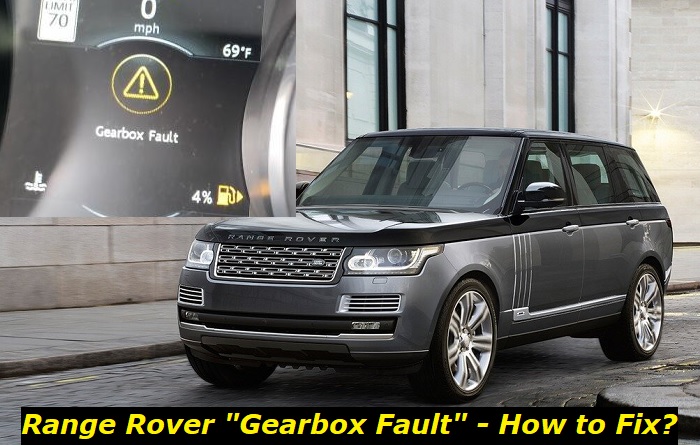Range Rovers are known for being hardy stubborn beasts of burden that eat rebellious territory for breakfast. Range Rover owners are notorious for talking people's ears off, going on about their car's superiority and the exciting adventures they have had with the powerful and reliable engines.
Gearbox fault message highlights
- Common reasons:shifter issues, TCU problems, transmission issues
- How to fix:check the codes, take it in for inspection
- Possible consequences:transmission may fail if ignored
- Priority level:High
- Can you drive?Carefully
- DIY repair:Impossible
- Repair price range:$300-$4,500

What To Do When Your Gearbox Malfunctions
Your gearbox will not up and quit on you out of the blue. Your Range Rover will have tried to direct your attention to the ailing gearbox using a wide range of symptoms. Experienced drivers learn how to speak their Range Rover's language and can often sniff out the problem when any of their components are not running as they should.
Your Ranger Rover will do more than present the telltale signs of a troubled gearbox - peculiar noises and difficulty shifting gears.
Whether you are a petrolhead or just beginning to look under the hood, these symptoms will help you discern what is going on in your gearbox. These symptoms will help you zero in on the malfunction in your gearbox and implement the appropriate solutions.
Common Symptoms of Faulty Gearbox
The following are symptoms of a faulty gearbox that you should be on the lookout for in your engine;
1. Hard Shifts
When you have a Range Rover with high mileage or one that is highly neglected, you will most likely experience rough and hard shifting issues while accelerating. You may also notice a lurch shifting between neutral, drive, and reverse.
Hard shifts are mostly experienced when you attempt to start your Range Rover without allowing a sufficient warm-up period. A defective gearbox does not exclusively cause hard shifts. Hard shifts are often accompanied by a customary check engine light that could point to various problems.
Possible Causes
If your hard shifts are due to gearbox trouble, your solenoid valves are likely to blame. When normal wear occurs to the solenoid valves or when you fail to make fluid changes over time, your Range Rover's valves may begin to leak or stick. A lack of smooth and controlled solenoid movements causes annoying difficulties when shifting gears.
Solution
You are advised to contact your dealership and schedule an appointment to have all your solenoid valves replaced. Alternatively, you can rely on a certified mechanic to help source high-quality after-market replacements compatible with your Range Rover.
2. Strange Sounds When Downshifting From 2nd to 1st
Several drivers of Range Rovers fitted with the 6-speed auto transmission have reported experiencing this problem, especially during downshifting. When reducing your speed and downshifting gears from the second to the first, you may hear a strange and alarming sound.
The sound may or may not be accompanied by a flashing check engine light. Other than the sound, you are not like to experience any other signs of mechanical failure.
Possible Cause
Peculiar noises when shifting from second to first gear are typically caused by wearing out of the mechatronic sleeves that connect your valve body assembly to the transmission. This component is likely to become fragile and crack over time, especially those made of rubber.
Solution
You are advised to have your dealership inspect and diagnose your car. Once the problem is confirmed, the dealership is likely to replace your harness connector and sleeve assembly.
3. Slipping When Shifting Into 4th Gear
Range Rovers with a 6-speed automatic transmission can develop a gear slip when shifting from the 3rd to the 4th Gear. When this happens, the delay in changing gears is very harsh on your transmission and engine components. If this condition is left unchecked, your transmission is likely to go into limp mode. Your Range Rover's check engine light is also likely to come on.
Possible Causes
This happens if there is a damaged E-clutch drum or excessive wear to the E-clutch system. When the E-clutch system is damaged, excessive wear will lead to harsh and delayed shifting to the 4th Gear. The intense engagement will be a result of mismatched gear speeds. You will do away with this problem when you rebuild the E-clutch system.
When the cause is worn bores or sticking solenoids inside the valve body, it alters the hydraulic pressure and affects gearchanges. This damage does not activate the check engine light not unless the problem is electrical.
Common Causes of a Range Rovers Gearbox Malfunction
Range Rover models may experience gearbox issues, and it is advisable to take note of common symptoms of an engine facing gearbox issues. Below are some of the symptoms of a faulty gearbox:
- Low transmission fluid level -When you are driving your car unknowingly with low levels of transmission fluid, it can result to causing several issues. These issues include; no shifting, erratic shifting, grinding noises, limp mode, delayed shifting, and checking the engine light going on.
- Worn-out bands -When your engine operates with worn bands, it may cause some issues. These issues result from worn bands; shifting at high RPM, no reverse gear, delayed shifting, no gear at all, and harsh shifting.
- A Damaged Torque Converter -A car with a damaged torque converter may experience slipping gears and shudder, which leads to transmission fluid overheating.
- A Faulty Shifter Module -When your vehicle's shifter model gets damaged, it causes problems like gears not going in the selected Gear or difficulty changing gears.
- A Damaged Valve Body -This part is very complex and can be damaged in several ways. When it fails, it can cause difficulty in shifting gears, limp mode, and trouble shifting between gears.
- A Damaged Speed Sensor -If you experience difficulties shifting gears or are stuck in limp mode (emergency mode), the problem may be with the vehicle speed sensor.
- The Brake Light Switch -When your engine's brake light switch is damaged, the button can prevent the stick shift from changing to another gear and remain in parking mode.
- Steering Angle Sensor -This sensor is used in the ABS and transmission control modules. If the steering angle sensor is damaged, the fault codes are displayed together with traction control lights.
- Software Issues -Problems associated with software malfunction in the transmission control unit (TCU) can lead to erratic shifting issues.
- Low Battery Voltage -Though not very often, your transmission can be stuck in limp mode when your battery has low voltage. By the way, we have described the problem with the RR battery and charging system in one of our previous articles - have a look!
How To Fix Your Gearbox Problems
To fix your engine's gearbox problems, follow the following procedures to take it to its normal operations.
- Transmission Adaptation Reset
New Range Rover models can be fixed by resetting the transmission adaptation back to factory settings. You should use an advanced scanner and reset the automatic transmission adaptation to reset. Do not carry out this procedure for the high-mileage Range Rover.
- Inspect Transmission Fluid Level
During starting, you should warm up the car for fifteen minutes so the transmission fluid can get warmed up. Skip this step if your transmission is slipping. Inspect the transmission fluid using the dipstick. If you confirm that the levels are low, you should add the transmission fluid.
It is crucial to note that not all Range Rovers will have a dipstick. You must loft the car from the ground to inspect it via the fill hole if it doesn't have one.
- Read The Transmission Fault Codes
After following all those procedures, you should familiarize yourself with the various fault codes associated with the transmission control module (TCU). To read these codes, you must have an OBD-II transmission scanner. Do not use primary scanner readers, they may show a generic code or may not show a fault code.
Conclusion
Gearbox problems are not the DIY type. It is best to entrust your Range Rover to the dealership or a credible auto repair shop for proper diagnosis and repair. The sooner you call in the professionals, the less expensive the final bill is likely to be.
About the authors
The CarAraC research team is composed of seasoned auto mechanics and automotive industry professionals, including individuals with advanced degrees and certifications in their field. Our team members boast prestigious credentials, reflecting their extensive knowledge and skills. These qualifications include: IMI: Institute of the Motor Industry, ASE-Certified Master Automobile Technicians; Coventry University, Graduate of MA in Automotive Journalism; Politecnico di Torino, Italy, MS Automotive Engineering; Ss. Cyril and Methodius University in Skopje, Mechanical University in Skopje; TOC Automotive College; DHA Suffa University, Department of Mechanical Engineering






Add comment